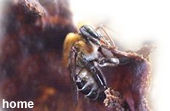Métodos de Pesquisa
Laboratório de Abelhas - USP
-
Item 03 -
ECOETOLOGIA DE INSETOS SOCIAIS
MÉTODOS
1) Mapeamento de favos de cria
3) Marcação de rainha fecundada (rainha fisogástrica) ou outros indivíduos da colmeia
4)
Introdução de rainha de uma espécie poligínica
em uma colônia órfã
5) Morfometria
HOW TO DETERMINE SIZE IN ALIVE STINGLESS BEES
By Márcia Ribeiro
Objective
In many situations is useful to determine the size of bees (see for
example Ribeiro & Alves, 2001), but not always we can, or have the
intention of sacrificing them in order to measure their size after they
are dead. Therefore, this simple and quick method was developed to get
the measurements from alive animals. Using a special apparatus (easy
to build), it is possible to get some morphometric measurements without
causing any harm to the bees, such as queens, workers or males. Manipulation
causes no harm to the bees and they can be returned to their colonies
soon after the measurements.
Fresh weight can also be obtained in order to determine the bees' size, because usually mass and morphometric measurements present a high Spearman's rank correlation coefficient (a non-parametric method is used because often these data are not normally distributed, for details on statistics see Zar, 1999).
Material
1. insect collector
2. plastic tubes with spongeous material at the extremities
3. analytical balance
4. stereomicroscope equipped with an ocular micrometer
5. apparatus for measurements (described bellow)
6. entomological tweezers
7. refrigerator
Fresh
weight
Using a insect collector (fig. 1), the bee(s) to be measured can be
easily collected at the nest, and placed into a plastic tube, previously
weighed in the analytical balance (0.1mg) (fig. 2).
Morphometric
measurements
Before the measurements each animal must be immobilized by low temperature
(one minute at -8.0oC), at the freezer of the refrigerator. Then it
must be put immediately into the apparatus and taken to the stereomicroscope
equipped with an ocular micrometer. Usually, the bee will wake up quickly
and therefore, the measurements must be done as soon as possible. Three
measurements are normally easy and fast to do: maximum head width, medium
interorbital distance (i.e., the distance between the eyes), and intertegular
distance (i.e., the distance between the tegula, the insertion of the
wings). When possible, a length measurement is also useful, but not
always is easy to determine clearly where the thorax finishes and the
abdomen starts (see Michener, 1965, for details on bee morphometry).
Description
of the apparatus used to measure
This apparatus is made of a spongeous material, containing concavities
of different sizes to accommodate the bee abdomen (obviously the larger
cavities are adequate for queens, and the smaller ones for virgin queens,
workers and males) (fig. 3). The spongeous material is supported by
a metal structure, and when the bee is already placed in the cavity,
a piece of glass must be put over it, in such a way to keep its head
and thorax in a horizontal position for doing the measurements (fig.
4).
 |
 |
| Fig.1.
Bee collector with some bees already collected |
Fig.2.
Analytical balance |
 |
 |
| Fig.
3. Apparatus to measure the bees |
Fig.
4. Queen in an adequate position, ready to be measured. |
References
MICHENER, C.D. 1965. A classification of bees of the Australian and South Pacific regions. Bull. Amer. Mus. of Natural History, 130: 1-362.
RIBEIRO, M. DE F. & ALVES, D. DE A. 2001. Rev. Etologia, 3(1): 59-65.
ZAR, J.H. 1999. Biostatistical analysis. New Jersey. Prentice-Hall
